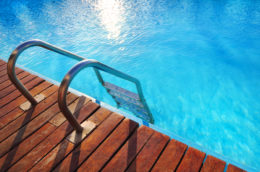When the air gets cooler and drier each evening, pool owners and operators will notice…

What Can I Do If My Swimming Pool Is Leaking?
Let’s assume that you read my earlier post and performed the world famous Bucket Test and your pool water dropped more than the bucket water did so we have a leak. What do we do now? If the leak is less than an inch a day, it’s very likely that my favorite sealer, Lo-Chlor Leak Sealer will take care of it.
This unique product seeks out and plugs minor leaks in pools. It starts with a high pH of about 12. When added to pool water it assumes the pH of the pool, (7.2 – 7.8) and becomes more fluid in the water but when it contacts air through a leak site, it thickens and forms a chemical plug at the leak and solidifies. Since every leak is different, it’s pretty tough to offer any kind of guarantee but when you consider the cost of digging up pipes or cutting through concrete, I believe that Lo-Chlor Leak Sealer is always worth a shot.
How to Use Leak Sealer
Leak Sealer will clog the filter elements so always bypass the filter. If you have a multi-port control valve, place it in the recirculate or bypass position. If you don’t have a control valve, simply remove the element(s) or grids. Also, shut down any ozonators, ionizers or salt chlorine generators.
If you know where the leak is, at the light for instance, shut off the pump and pour the sealer into the pool in the area of the leak.
If the leak location is unknown, shut off the pump and pour the sealer slowly into the skimmer. Allow it to settle into the pipe for 30 minutes.
If you have identified a single pipe as the source of the leak, you may be able to rig a funnel and hose to get the sealer directly into that pipe. Remember that water and leak sealer flow downhill so asses the elevation of the pool and piping to figure out which end to introduce the sealer to and understand that the piping is likely buried below the frost line for your geographic area.
Leak sealer is heavy and will sink and collect in the bottom of the pool. If possible, connect your vacuum hose to your vacuum head and place the weighted head in the bottom of your pool while connecting the other end to your vacuum inlet or skimmer. This will keep the sealer circulating through the pool as you turn the pump back on for at least 8 hours and preferably 24. Check to see if the leak has stopped or slowed. Sometimes a second application will succeed when a single try doesn’t quite do it.
Too Much Leak for a Sealer?
Larger leaks or leaks that the sealer doesn’t remedy may require professional attention. Check with your local swimming pool service company or store and ask for a recommendation for a leak specialist. Many now use electronic means of locating and even repairing leaks with minimal effect on the yard or decking. In addition, I’ll discuss some additional methods in another post.
The Leak Stopped
With your leak sealed and the parade of pachyderms no longer tanking up from your pool, its now time to stretch out in the floating lounger with a tall sweet tea and remember what owning a pool is all about… Cheers!
Written by Hank Graham




This Post Has 0 Comments